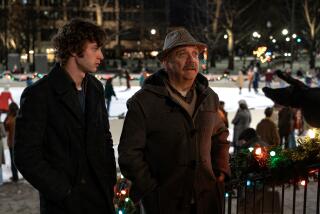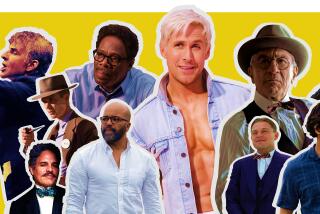Baz Luhrmann wants to ‘reveal’ more of ‘The Great Gatsby’
F. Scott Fitzgerald’s “The Great Gatsby” is widely recognized as a literary masterwork. Yet as even the book’s editor, Maxwell Perkins, said to Fitzgerald about a draft of the 1925 novel, the title character “is somewhat vague.”
Hazy doesn’t work in cinema, so when director Baz Luhrmann decided to bring “Gatsby” to the screen, he and his creative team went on the filmmaking equivalent of an anthropological dig. The goal: unearth what was left unsaid in Fitzgerald’s slender tale of Jay Gatsby, a millionaire bootlegger, and his unrequited love for a married socialite, Daisy Buchanan.
The film, opening May 10, overflows with all the touches you’d expect from the director of “Moulin Rouge!” — elaborate production and costume design, modern music in a period setting, theatrical acting — while hitting the seminal scenes and lines in Fitzgerald’s classic.
PHOTOS: The Roaring ‘20s on-screen
But Luhrmann recognized the danger of missing “Gatsby’s” emotional forest for all of the novel’s expositional trees. So he, co-screenwriter Craig Pearce and a cast headed by Leonardo DiCaprio (who plays Gatsby), Carey Mulligan (Daisy) and Tobey Maguire (narrator Nick Carraway) looked for clues wherever they could be found — and then came to their own storytelling conclusions.
Luhrmann delved into Fitzgerald’s life, letters and other writings, ultimately relying heavily on “Trimalchio” — Fitzgerald’s early draft of “The Great Gatsby” — and biographies of his wife, Zelda, whom the novelist described as the first American flapper. One of Daisy’s lines comes from a note the novelist sent to his early love, Ginevra King.
When the source material left some questions unanswered, Luhrmann followed his own hunches. A case in point: The novel suggests that Gatsby, a former soldier, penned a heartbreaking letter to Daisy on her wedding day. The book never reveals the contents, but its impact on Daisy is profound.
Luhrmann and his team decided that the missive was Gatsby’s confession of undying love in a relationship doomed by his poverty and set out his thoughts to Daisy. “You see my uniform hid the truth that I was poor,” the letter reads in the film’s imagination, its lines meticulously inked with a turn-of-the-century fountain pen on vintage paper (in handwriting that mimicked Fitzgerald’s, no less).
The full note never appears on screen, but the fact that Luhrmann felt compelled to create it in such detail speaks to the director’s attention to detail and the intricacies of his creative embellishments.
“I have one duty — to the best of my ability to captain the storytelling team, and to tell and reveal the story,” said the 50-year-old Luhrmann, who followed his Oscar-nominated “Moulin Rouge!” with the critical and commercial disappointment “Australia.” “I set out to reveal ‘The Great Gatsby,’ but I also set out to do a movie of it.”
While Gatsby’s famous bashes are even more excessive in Luhrmann’s imagination than in the novel, with fireworks choreographed to Gershwin’s “Rhapsody in Blue,” the director said he labored to keep the story intimate and immersive.
He filmed several sequences in long takes, as if “The Great Gatsby” were live theater, and shot it in 3-D; the stereoscopic technology, Luhrmann said, heightens the film’s emotions, moving the audience from spectators to participants. “It was our poetic glue,” the director said of 3-D.
The director briefly needed his own adhesive to keep “The Great Gatsby” from falling apart. Worried about its budget, Sony Pictures backed out of the movie (the film was ultimately co-produced by Warner Bros. and Village Roadshow), and numerous production delays, some tied to weather, postponed the film’s release from last fall to May.
Luhrmann began to consider adapting the novel after listening to it as a recorded book while traveling on the Trans-Siberian Railway after finishing 2001’s “Moulin Rouge!” But it took a while to figure out how to translate “Gatsby” into a cinematic language that preserved Fitzgerald’s voice.
His answer, and one of the film’s most notable departures from the novel, is revealed as soon as the movie starts. Traumatized by all he has witnessed, Nick is convalescing in a sanitarium. A doctor prescribes that he write about what happened in West and East Egg, the respective New York homes of Gatsby and Daisy, and Nick’s recollections become the movie’s framing device.
That hurdle behind him, Luhrmann and his team turned their attention to the film’s supporting characters: Daisy’s husband, Tom (Joel Edgerton); Tom’s mistress, Myrtle Wilson (Isla Fisher); Myrtle’s husband George (Jason Clarke); and Daisy’s friend and accomplished golfer Jordan Baker (Elizabeth Debicki). The task, as DiCaprio said, was tying to sort out “the choose-your-own interpretation of who these people are.” “What makes ‘Gatsby’ the book that it is,” the actor said, “is that people still have conversations about it.”
Is Gatsby truly in love with Daisy, or is she just another arrow in his social-climbing quiver? Why does Daisy choose to stay with Tom, whom she knows to be a serial philanderer? Would Gatsby and Daisy eventually have ended up together were it not for George Wilson’s bullet? The movie has an opinion about all such questions.
PHOTOS: The Roaring ‘20s on-screen
Luhrmann said that adapting any well-known text, just as he did with DiCaprio in “Romeo + Juliet,” will raise someone’s dander. And it may not just be his telling of the story that some find fault with — his unconventional musical choices may prove polarizing.
Just as he used songs by Elton John, David Bowie and U2’s Bono in “Moulin Rouge!,” Luhrmann infused “The Great Gatsby” with tracks from an array of modern musicians — Florence Welch and Lana Del Rey, plus Kanye West and the husband-and-wife duo of Beyoncé and Jay-Z (the last serves as an executive producer).
Luhrmann said criticism is inevitable whenever you touch a hallowed text, be it by Shakespeare or Fitzgerald. “If you go near anything, you are going to be tarred and feathered,” he said.
Mulligan agreed some censure is certain. “There will definitely be some purists who won’t respond well to any deviation of what’s exactly written in the text. I feel that way about my favorite books,” she said. “But I think people will come away witness to an epic love story.”
PHOTOS AND MORE
Roger Ebert: Career in pictures
ENVELOPE: The latest awards buzz
PHOTOS: Greatest box office flops
More to Read
Only good movies
Get the Indie Focus newsletter, Mark Olsen's weekly guide to the world of cinema.
You may occasionally receive promotional content from the Los Angeles Times.











